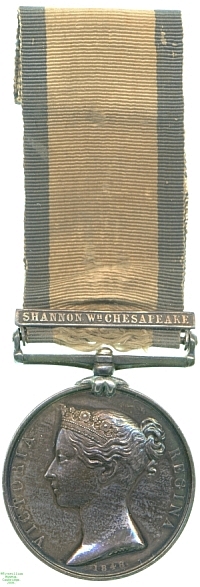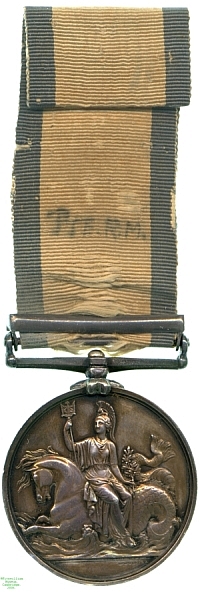
Obverse, a bust of Queen Victoria

Reverse, Britannia with a trident seated sideways on a seahorse

Obverse, a bust of Queen Victoria |

Reverse, Britannia with a trident seated sideways on a seahorse |
Just as in 1848 the extensive land campaigns of the Napoleonic Wars and the other conflicts of the pre-Victorian era were recognised by the issue of the Military General Service Medal, those serving in the Navy at the time were recognised with the Naval General Service Medal. As with the Army equivalent and the East India Company's related award, many of the battles for which the medal was awarded had been fought so long ago that few if any claimants survived.
In addition, bars were awarded for many actions whose significance and size were, despite the heroism displayed by those involved, relatively minor. The result was that many of the bars were issued in tiny numbers, with some combinations all but unique, and the medals command a very high price among collectors because of this rarity and individuality. This in turn, along with the manufacture in most cases of more bars than were eventually issued, has led to the `improvement' of many common awards where recipients' names are shared with those present at `rarer' battles. The medal also shares with the Military General Service and Army of India Medals the oddity that Queen Victoria, whose portrait they bear, was not the ruler under whom the battles for which it was awarded were fought.
Although the years 1812 to 1814 are mainly remembered for the closing of the ear of Napoleonic France, Britain was also at war on the other side of the Atlantic during this period, with the United States. The `War of 1812' originated in British arrests of United States ships in the cause of the blockade of France necessitated by the Napoleonic Wars, and various resentments left over from the American War of Independence. It featured two successive US invasions of Canada, both unsuccessful, and a British sack of Washington DC during which its public buildings, including the Capitol, were burned. These engagements indicate the seesawing successes of the war, which was ended in 1814 by the Treaty of Ghent which restored the territorial `status quo ante'.
Although naval warfare of this period was hideously costly in lives and limbs, and most of the recruits unwilling conscripts, it was often fought in a rather different spirit to modern combat. Proof of this may be taken from the battle between HMS Shannon and the USS Chesapeake on 1 June 1813. Shannon, under Captain Philip Broke, found Chesapeake and USS Constitution refitting in Boston harbour, and sent Chesapeake's captain a challenge to come out and fight. Chesapeake eventually did so, and the fifteen-minute fight resulted in Broke's crew boarding and taking over the US vessel, although Broke was severely wounded aboard her. A further mark of the age is that when the US vessel left port it was accompanied by several pleasure boats whose owners were anxious to see the action from close by.
44 Naval General Service Medals were awarded for service aboard Shannon in this action, and this one was awarded to John Filer, a member of her Royal Marines contingent. His presence on the ship at this time has been verified, and the Medals Roll confirms the award of this medal to a man of this name. Lester Watson purchased this medal at some point before 1928; it had previously come up for sale in an auction at Glendinings in June 1919.